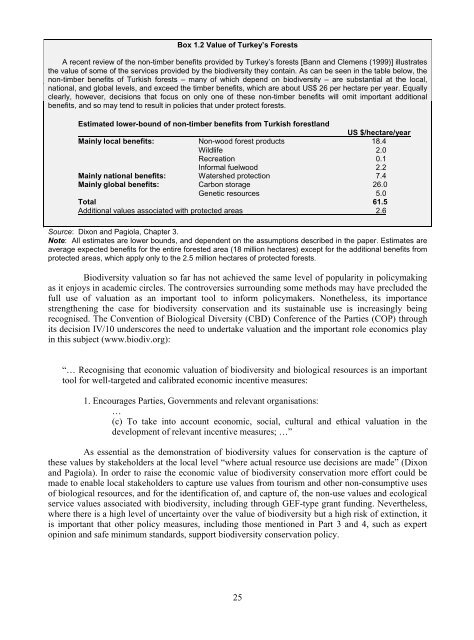Valuation of Biodiversity Benefits (OECD)
Valuation of Biodiversity Benefits (OECD)
Valuation of Biodiversity Benefits (OECD)
- No tags were found...
Create successful ePaper yourself
Turn your PDF publications into a flip-book with our unique Google optimized e-Paper software.
Box 1.2 Value <strong>of</strong> Turkey’s ForestsA recent review <strong>of</strong> the non-timber benefits provided by Turkey’s forests [Bann and Clemens (1999)] illustratesthe value <strong>of</strong> some <strong>of</strong> the services provided by the biodiversity they contain. As can be seen in the table below, thenon-timber benefits <strong>of</strong> Turkish forests – many <strong>of</strong> which depend on biodiversity – are substantial at the local,national, and global levels, and exceed the timber benefits, which are about US$ 26 per hectare per year. Equallyclearly, however, decisions that focus on only one <strong>of</strong> these non-timber benefits will omit important additionalbenefits, and so may tend to result in policies that under protect forests.Estimated lower-bound <strong>of</strong> non-timber benefits from Turkish forestlandUS $/hectare/yearMainly local benefits: Non-wood forest products 18.4Wildlife 2.0Recreation 0.1Informal fuelwood 2.2Mainly national benefits: Watershed protection 7.4Mainly global benefits: Carbon storage 26.0Genetic resources 5.0Total 61.5Additional values associated with protected areas 2.6Source: Dixon and Pagiola, Chapter 3.Note: All estimates are lower bounds, and dependent on the assumptions described in the paper. Estimates areaverage expected benefits for the entire forested area (18 million hectares) except for the additional benefits fromprotected areas, which apply only to the 2.5 million hectares <strong>of</strong> protected forests.<strong>Biodiversity</strong> valuation so far has not achieved the same level <strong>of</strong> popularity in policymakingas it enjoys in academic circles. The controversies surrounding some methods may have precluded thefull use <strong>of</strong> valuation as an important tool to inform policymakers. Nonetheless, its importancestrengthening the case for biodiversity conservation and its sustainable use is increasingly beingrecognised. The Convention <strong>of</strong> Biological Diversity (CBD) Conference <strong>of</strong> the Parties (COP) throughits decision IV/10 underscores the need to undertake valuation and the important role economics playin this subject (www.biodiv.org):“… Recognising that economic valuation <strong>of</strong> biodiversity and biological resources is an importanttool for well-targeted and calibrated economic incentive measures:1. Encourages Parties, Governments and relevant organisations:…(c) To take into account economic, social, cultural and ethical valuation in thedevelopment <strong>of</strong> relevant incentive measures; …”As essential as the demonstration <strong>of</strong> biodiversity values for conservation is the capture <strong>of</strong>these values by stakeholders at the local level “where actual resource use decisions are made” (Dixonand Pagiola). In order to raise the economic value <strong>of</strong> biodiversity conservation more effort could bemade to enable local stakeholders to capture use values from tourism and other non-consumptive uses<strong>of</strong> biological resources, and for the identification <strong>of</strong>, and capture <strong>of</strong>, the non-use values and ecologicalservice values associated with biodiversity, including through GEF-type grant funding. Nevertheless,where there is a high level <strong>of</strong> uncertainty over the value <strong>of</strong> biodiversity but a high risk <strong>of</strong> extinction, itis important that other policy measures, including those mentioned in Part 3 and 4, such as expertopinion and safe minimum standards, support biodiversity conservation policy.25












